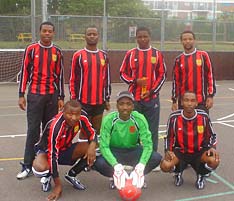Matthew Bowcock: Are we visible? Looks like it.
A second look at the third sector
One third of all people who volunteer do so in sport but do third sector professionals realise this, recognise sport’s impact or regard sport as anything other than a means to an end? Mick Owen went back to an old stamping ground to find out.
Matthew Bowcock: Are we visible? Looks like it.
The chief executive of Nottinghamshire County Council shares a problem with a great many people: he admits that he is “confused about what to call the sector that is ‘not statutory’.” In his introduction to the final day of the Community Foundation Network’s (CFN) biennial conference Michael Burrows variously referred to the voluntary and community groups, social enterprises, charities, cooperatives and mutuals that represent “a different way of doing business for the whole of the public service” as the “voluntary sector”, the “community sector” and the “third sector”. But if he is confused about its label he has no doubt about its value as a partner and believes that “the voluntary sector has a duty to keep local authorities in their place” and to continue to bring “trust, equity, respect and openness” to the relationship. He really was very positive but when you attend a conference called Grassroots Philanthropy: Changing Our World Together with a delegate base who spend their working lives giving away money it would be very difficult indeed to come the curmudgeon.
Over three days more than 600 delegates attended the East Midlands Conference Centre (EMCC), all of whom were from a sector that covers sport, leisure and culture but goes much further; and they came from all over the UK and much further afield, notably from South Korea, the Philippines and Italy. So encompassing is the network and so successful is its proselytising that those within it call it ‘the Movement’. As an entity, community foundations distribute grants each year worth £70 million to community organisations and they fund everything from lunch clubs for old ladies, stroke support and breastfeeding support groups to PTAs, tenants’ associations, after-school homework clubs and miners’ welfare dominos teams. Between them the 51 individual community foundations manage funds for the Cabinet Office, blue-chip companies, little local endowment funds, the Big Lottery and Comic Relief. And 95% of the UK population live “in the area of benefit of a community foundation”. They are big. But who are they? What makes them tick? Are they ‘our kind of people’?
The first thing that strikes a short-term visitor to the CFN milieu is the normalness of its inhabitants. Few sandals, very little cheesecloth and not a kaftan to be seen. This is not the hippy fringe, which, given the funds they raise and disburse, should not be a surprise. There are some pockets within the third sector professional family who do favour lentils and unbleached cotton but they were not in Nottingham. There is, though, a preponderance of posh. The language used from the platform is erudite and assumes an educated audience, which with 70% of the workforce having degrees earned in the main before New Labour democratised higher education, is an expectation well founded. The use of Breugel’s Fall of Icarus as a motif for the social apathy CFN needs to combat as it works towards “building compassionate communities” rounds off the chairman’s presentation and emphasises that these people are bright, aspirational and rather clever.
The chair, Matthew Bowcock, has a background in “technology entrepreneurship, company start-up, international marketing, venture capital and private company directorship” and his review of CFN’s current situation asks questions and sets challenges. One phrase does both: “Are we visible?” CFN’s 12,000 donors are a “tiny proportion of the mass affluent who could give” and if 20,000 community groups have benefited thanks to CFN how many more could benefit from that philanthropy? The politicisation of the charity sector has, he argues, played its part in creating a situation in which “unfashionable programmes” are missing out on funding; with 85% of charity giving going to 5% of charities, there is a disparity he calls “the survival of the cutest”. But as CFN’s agenda chimes with current political thinking against “central command and control” and the movement offers quality accreditation within a “common approach that links unique situations” he sees a bright future. And to give a glimpse of how bright, he announced what may well be a ground-breaking strategic partnership between social enterprise LocalGiving – which works hand in glove with CFN – and the donations website JustGiving. How many hockey players, orienteering coaches and samba band treasurers have wanted to run a marathon, walk Hadrian’s Wall or sit in a bath of beans with funds raised going to their own community group but found themselves stymied by the major donations websites’ refusal to facilitate giving to any entity bar registered charities? JustGiving is such a good idea that it has cornered the market in linking small fund-raisers to small donors and then to the charities that the first specify and the second may have little concern about. When the new partnership comes into effect any group that has been vetted by a local community foundation will be able to receive its beneficiaries’ beneficence. Eight million donors will be linked to 50,000 recipients, bringing more money to the sector than the entire CFN handles annually. Sports clubs will be able to start to see the benefit as long as they engage with their local foundation.
There is an argument that community sport has been woefully slow to spot the opportunity that recognising its place in the third sector would represent. Although there is anecdotal evidence that one county sports partnership’s new funding officer spent the first month in post coordinating applications to the grassroots grants fund under the guise of “attracting resources” into the county, the sport system as a whole has been slow on the uptake. This may in part be the result of CFN’s acknowledged lack of visibility but when £150 million opportunities such as the Local Network Fund (up to £7,000 for individual community groups with appropriate programmes in need of support) open and close with barely a blip on sport and leisure professionals’ radar the failing may well lie closer to home. One thing is sure: the people who work in community foundations and third sector structures like them will not be beating a path to sport and leisure’s door. They have radars of their own and they are attuned to social need, compassion and community empowerment, a quality that Dame Suzi Leather, the chair of the Charities Commission who spoke from the platform, called “the most important behaviour needed today”.
Closer to the sharp end of community giving, Alice Meason is the grants director for the Quartet community foundation in Bristol, so called because it covers four local authority areas including the city itself. She has worked in the third sector long enough to know its ways and to understand how it thinks. When asked for her view of sport, she answered: “Well, there’s a lot of it and it involves a lot of people.” But is it important for community foundations to engage with sport? “There are a lot of ways in which sport can help us build a better future for local people and where the programme offered meets our aims we will consider funding it.” She offered an example a programme where football is being used with a refugee group to help with integration. “We manage the Sport Relief fund for Comic Relief and we were asked to consider a group called the Bristol Zimbabwe Football Team who use football to bring refugee Zimbabweans together and then help them integrate with other communities. Sport Relief is keen to see its funds go beyond the obvious sports such as football but the panel that considers the Sport Relief applications includes a representative of Wesport [the county sports partnership] and with his knowledge of the club available to us we had no difficulty in making a grant to support the football club’s development. It meets our aims.”
This is the crux: sport is seldom a charitable case. Ian Wright going into a prison and using football as a motivation for inmates to break the cycle of offending behaviour may well be an example of sport helping to hit social aims but sticking a logo on a primary school team and calling it creating school-club links is not. When Lady Leather – or Dame Suzi as she was universally referred to – gave her presentation she spoke about a process called “precision agriculture” where fields are minutely mapped and variations in yield enable the targeting of fertilisers and pesticides. By doing away with the blanket treatment of crops the agri-business – the word ‘farmer’ seems inappropriate – can save time and money while increasing yield. She believes that the new “high end” philanthropists and indeed the same old government agencies will respond to “precision funding” as it promises “a measurable impact on human lives” in the communities they want to help, often the ones from which they came. Growing and sustaining participation in grassroots sport and creating opportunities for people to excel are not parts of the cornfield likely to attract a dose of charitable fertiliser.
Sport is played and then run by selfish people. The passion for sport to which sports development graduates proudly lay claim at interview necessarily precludes a passion for social justice. Passions, unlike sorrows, come singly not in battalions and the idea that the clubs that form the core of the sport system are in it for anyone but themselves is a coat on a shoogly peg. One thing is certain: dressing up a coaching scheme aimed at bringing more paying customers into your Wednesday evening judo session as “learning new skills, exposure to other culture and languages and changing behaviour and attitudes” is not going to fool the very nice, really quite clever people who make up the Movement.
Mick Owen is the managing editor of The Leisure Review.
The Leisure Review, October 2009
© Copyright of all material on this site is retained by The Leisure Review or the individual contributors where stated. Contact The Leisure Review for details.
Download a pdf version of this article for printing
Zimba FC: plenty of the Movement off the ball

On side: how often is sport a charitable case?

Dame Suzi Leather